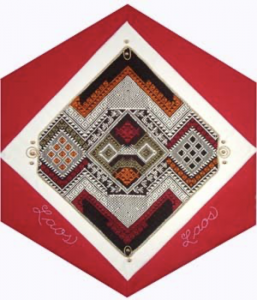Laos

The Block
The art of weaving is still very much a home industry in Laos, where some of the world’s finest weavers—well respected and held in high regard––can be found. The craft is performed almost entirely by women and is a mark of womanhood that takes years to master. At one time a girl could not be married until she had mastered it.
This block features a fine example of ‘discontinuous supplementary weft’ weaving, provided by Mme Khampiene Phimmasone. Similar to tapestry weaving, this technique, called kor, involves working in small amounts of colour in selected areas. Stylized dragons and flowers are incorporated within its geometric forms, and earthy tones of orange and green, along with white and magenta, are interlaced by hand under the weaving’s weft threads to create the complex designs. A double band of couched gold work, accentuated with gold beads, frames the piece.
Cultural Profile
Laos is one of the most isolated countries in the world and one of the regions in South East Asia least touched by modern civilization. The landlocked nation, which is divided into 16 provinces and one municipality, was once known as Lan Xang (‘the Kingdom of a Million Elephants’), the name given to it in 1353 by King Fa Ngum. It was renamed Laos during the French colonial period and achieved full independence in 1953. Central Laos is the site of the historic Plain of Jars, a large plateau on which hundreds of ancient stone jars are placed, some as high as three metres and weighing up to one ton. The Mekong River flows through the country and interestingly is home to a rare species of freshwater dolphin. The three main ethnic groups are the Lao Sung (Lao of the mountains), the Lao Theung (the Lao of the lower mountain areas) and the Lao Loum (Lao of the lowlands). The official language is the rich and colourful Lao, although French and English are widely spoken as well.
Laos’ long tradition of oral literature includes folk tales, proverbs and poems, some of which are quite lengthy and take up to six hours to recite. Sessions in which lam or khap (love poetry set to music) is performed can last up to 72 hours. Folk music, which is not written down but played from memory, is an important part of the culture and is often accompanied by dancing or maw lam (theatre). Traditional instruments include the khen, an elaborate mouth organ made of 16 bamboo sticks, buffalo horns, and tam tam drums. The country’s rich architectural heritage includes the capital city of Vientiane’s Great Stupa, which has become a national symbol.
Traditional crafts include pottery and the creation of gold and silver jewelry, which is seen as a form of portable wealth. Laotian men work in wood, bone or stone to skilfully create carvings with religious significance or ones that portray scenes from daily life.
Women are renowned for their intricate silk weaving, made on horizontal looms or back strap looms. Silk is the most widely-used fibre since it is readily available in the country, but hemp and cotton are also used. The rich textiles are used extensively in making the traditional outfits. These include the sinh, the tube skirt traditionally worn by women, the suea pat, a shirt, and the richly decorated sbai, a shawl-like garment wrapped around the upper body. These woven silks often feature embroidery as well. The patterns and colours of a sinh serve as indicators of where the wearer is from. The northern regions of Laos also produce ikat fabric, a technique where each thread of silk is tied and dyed individually before being woven into cloth. Indigo is widely used in Central Laos by the Black Hmongs, whose name derived from their use of indigo to make dark clothing. The Hmong also use indigo for creating batik designs on hemp cloth. Hmongs are also known for their elaborate jewellery and colourful embroidery featured in their traditional costume.
Laotians began immigrating to Canada in 1965 and since the 1980s, thousands have come here as refugees escaping the turbulence of war. Many are skilled and educated workers, most of whom have settled in larger cities across the country (Toronto, Montreal, Vancouver, Winnipeg, Calgary and Edmonton). Records indicate there are over 34,000 Laotians now living in this country.
Sponsor: Jim & Charita Warwick
